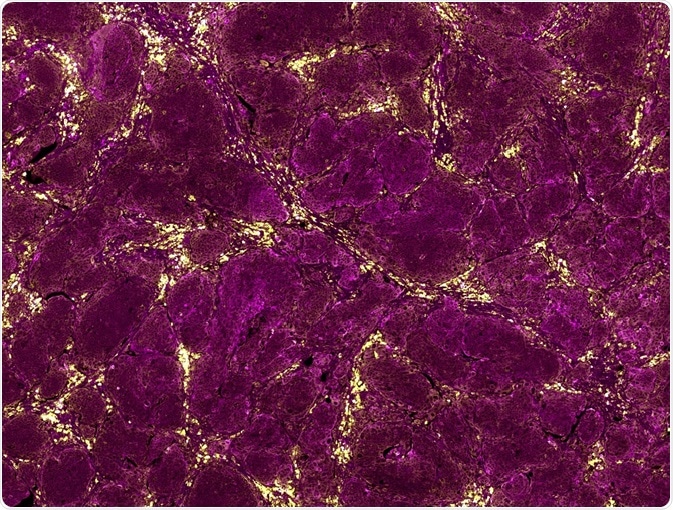Immunohistochemistry (IHC) is a popular method for visualizing the presence, concentration, and distribution of molecules within tissue. The method utilizes specific antibodies that bind to target antigens and is a very effective way of studying tissue architecture. However, cross-reactivity, low specificity and problems with antibody preparation can cause serious issues with background noise.
 Image Credit: Carl Dupont/Shutterstock.com
Image Credit: Carl Dupont/Shutterstock.com
Problem: Cross-reactivity and a lack of antibody specificity
Problems that lead to high background noise in IHC can have several causes, and therefore several solutions. Background noise due to incorrect antibody binding can be caused by an excessive concentration of the primary antibody, a lack of specificity by the second antibody, or antibody cross-reactivity.
Solution: Primary antibody titration
If the problem is caused by excessive amounts of primary antibody, the solution is to titrate the antibody to determine the optimal concentration. Titrations are regularly performed in even the most basic of laboratories and do not require specialized equipment or knowledge.
Solution: Invest in an antibody with high specificity and affinity for its target
If the problem is caused by cross-reactivity of the antibody, money may need to be spent on primary antibodies with guaranteed specificity to only their listed targets.
Solution: Reduce non-specific binding with negative control or blocking
If the cause of the problem is nonspecific binding of the secondary antibody, there are a number of possible solutions. Using a negative control without a primary antibody can help analyze the binding of the secondary antibody to solve the problem.
Otherwise, a secondary antibody that has been pre-adsorbed against the sample species’ immunoglobulin (Ig) can be used. Finally, the sample can be blocked using serum from the same host as the secondary antibody.
Problem: Improper sample preparation
Insufficient or improper sample preparation can have a major impact on signal-to-noise ratios in IHC. This problem can have several causes, with several solutions. However, current solutions tend to focus on altering the chemicals and reagents that are used. For example, if the problem is caused by insufficient blocking of non-specific binding, the protocol can be modified to increase the blocking incubation time, or a different blocking reagent can be used.
Solution: Changing reagents
A number of endogenous substances in tissues can be a cause of background noise in IHC. Endogenous peroxidase or phosphatase can cause background noise. Quenching of these substances can be increased by using 3% H2O2 solution for peroxidase, and 2 mM levamisole for phosphatase. Endogenous biotin and lectin can also cause background noise, and treatment of samples with streptavidin solution for biotin, and alpha-methyl mannoside buffer for lectins, can block these.
Solution: Improving preparation protocols
Sample preparation protocols that can be modified to reduce background noise include deparaffinization and tissue section preparation. Deparaffinization, which is done using dimethyl benzene, needs to be complete. This can be achieved by making the deparaffinization time longer and using only fresh dimethylbenzene.
In terms of tissue section preparation, thick sections can lead to incomplete penetration of the reagents. This can be fixed by simply preparing thinner tissue sections. Frozen sections can also cause higher background noise because they preserve more adhesive molecules. Therefore, IHC should be carried out on fresh sections to reduce background noise.
Other possible causes of background noise in IHC
Incubation temperatures and substrate concentration
Incubation parameters are integral to the success of IHC. Incubation at temperatures higher than 4 °C can be a contributing factor to high background noise, in addition to using too much substrate. High substrate concentrations can be solved by diluting substrate concentration and reducing the incubation time of the substrate. Otherwise, an alternative substrate with a higher signal to noise ratio can be used, such as metal-enhanced diaminobenzidine (DAB).
Autofluorescence and selecting a fluorophore
Using immunofluorescence as the detection system for IHC can introduce other background noise-related issues. For example, some samples are prone to autofluorescence which will make it more difficult to distinguish the target molecules.
Furthermore, certain fixation procedures that use formalin or paraformaldehyde fixatives can cause autofluorescence. If this is the case, the fluorophore can be replaced with one in a different color range. For example, formalin autofluorescence is usually green, so a fluorophore in the red range can be tried. If an infrared detection system is available, a fluorophore in the infrared range can be applied.
Further Reading
Last Updated: Feb 2, 2021